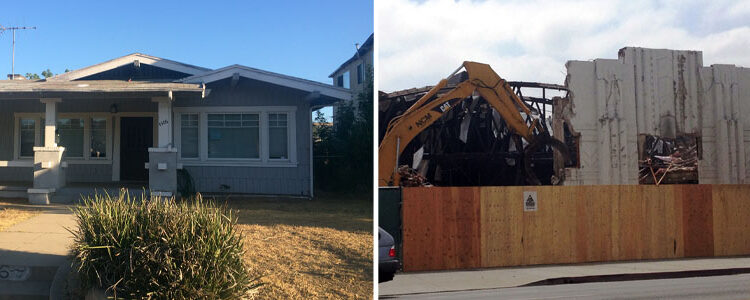
Demolition Notification Ordinance
What is the Demolition Notification Ordinance?
The Demolition Notification Ordinance is a citywide policy that requires public disclosure of demolitions planned for structures older than forty-five years of age.
What does it mean for me?
The Demolition Notification Ordinance can be an important preservation tool for unprotected historic buildings:
- Community members are empowered to prevent surprise demolitions.
- On-site, public postings help ensure a transparent notification process.
- The thirty-day notification window creates an opportunity to negotiate preservation alternatives and pursue stronger protections, including local landmark nomination.
Background
In late 2014, Los Angeles City Council passed the Demolition Notification Ordinance to create greater transparency in the development process for unprotected historic buildings. Councilmember Mitch O'Farrell introduced the motion in the wake of a series of high-profile demolitions, and the ordinance took effect in January 2015. The City Council voted to amend the ordinance in November 2017 to increase the notification requirements and provide greater clarity. The amended Demolition Notification Ordinance took effect on January 10, 2018.
The ordinance is a big win for Los Angeles' preservation community.
Before demolition permits can be issued for buildings older than forty-five years, the new Demolition Notification Ordinance requires property owners to inform abutting neighbors and their Councilmember's office of any planned demolition activity and to post a public notice on the property.
The ordinance creates a thirty-day window for stakeholders to potentially negotiate preservation alternatives if a significant historic property is affected. This could include nominating it for Historic-Cultural Monument (HCM) designation.
Community groups have quickly embraced the ordinance in response to teardowns in residential neighborhoods. For example, members of the public successfully nominated the Edinburgh Bungalow Court for HCM designation after a notice of demolition appeared on the property in September 2015.
Earlier losses of significant structures highlighted the need for a stop-gap measure.
The preservation community rallied around the June 2014 loss of the Mole-Richardson Studio Depot in Hollywood. In that case, the owner was able to acquire a demolition permit for the Art Deco building without triggering alarm because the property had not been landmarked and a replacement project was not yet known.
Additionally, two designated structures were illegally demolished within seven months of the Mole-Richardson. In April 2014, the owner of the San Marino Villas (HCM #870) demolished the Mediterranean Revival apartment building without any permits. In November 2013, the owner of an early 1920s Spanish Colonial Revival house in the Whitley Heights HPOZ tore down the property in its entirety, despite having been issued a permit for interior remodel work only.
If a building is found to have been demolished illegally, the City can also impose penalties under its "scorched earth" policy, including monetary fines and a five-year construction moratorium on the site.